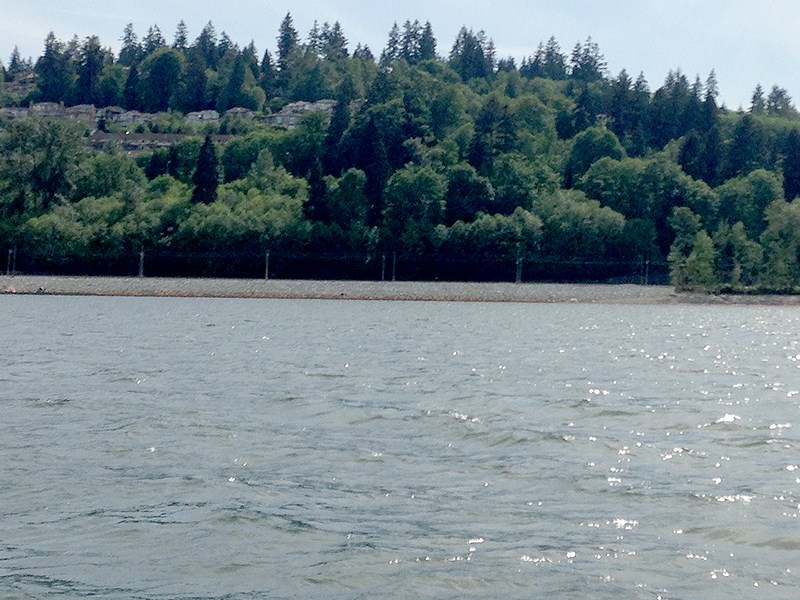Last week, the Tsleil-Waututh First Nation hosted an excellent science symposium about Burrard Inlet, which is part of their traditional territory.
The symposium brought together a number of scientists and environmental stewards who are concerned about the state of the environment in Burrard Inlet. By developing a new action plan for the inlet, the Tsleil-Waututh hope to be able to address critical information gaps and the lack of environmental oversight currently displayed by senior levels of government when important decisions are made about industrial impacts on the inlet.
Tsleil-Waututh means “people of the inlet.” For thousands of years, Burrard Inlet has been their home and the source of their sustenance. Belcarra Regional Park now encompasses one of their former village sites — called Tum-tumay-whueton — while a village site at the head of Burrard Inlet near Noons Creek — called Say-mah-mit — was where they came to catch returning salmon.
By 1972, industrial pollution resulted in a closure of the clam beds near their present reserve lands on the north shore of Burrard Inlet. For millennia, these clam beds were a vital food source for people of the Tsleil-Waututh. Today, more than 93% of the historic estuaries draining into the inlet have been lost due to development while more than 53 km of natural shoreline habitat has been destroyed.
One of the goals of the Tsleil-Waututh is to restore ecological health to the inlet so that their clam beds can flourish again.
Not too long ago, the environmental impacts of industrial activities fell under the purview of the Burrard Inlet Environmental Action Plan (BIEAP). Initiated in 1991 and modelled on a similarly successful initiative for the Fraser River (FREMP), BIEAP provided funding for essential research into the state of the inlet as well as regulating the activities of industry.
BIEAP also generated considerable public interest in the inlet and supported a number of volunteer activities, such as quarterly bird surveys throughout the inlet. Jointly funded by several levels of government, support began to diminish in 2003 and, under a decision of the Stephen Harper government, BIEAP and FREMP ceased to exist by 2013.
Decisions about industrial expansion are now made by the Port of Vancouver, and the process is thought to result in less balanced decisions than those reached by BIEAP. The Tsleil-Waututh hope they can provide some of the oversight that BIEAP once did as well as compile information on new threats to the marine environment such as plastics pollution and increasing underwater noise in addition to the ongoing loss of shoreline and an ever-growing industrial footprint.
One information gap currently being filled regards research on forage fish, which is supported in part by the Pacific Salmon Foundation and the BC Shore Spawners Alliance. Forage fish are small fish on which larger fish predate. Thus, they comprise a critical component of the food pyramid in the marine environment for both young salmon smolts and adult fish. Forage fish must be abundant to support populations of larger fish such as salmon. Despite their significance, little is known about their population densities or the location of their critical habitat in Burrard Inlet.
These fish include species such Pacific sand lance and surf smelt, both of which are known to occur in Port Moody Arm of Burrard Inlet. These fish require high intertidal habitat for spawning, so research is now being conducted to identify where their critical spawning habitat still exists in Burrard Inlet.
Ramona de Graaf of the BC Shore Spawners Alliance presented her findings at the Science Symposium and described how she is working with volunteers to assess surf smelt populations in Burrard Inlet. On May 28, she will be working with volunteers from Mossom and Noons Creek hatcheries to assess sites in Port Moody Arm.
One area where spawning habitat may have recently been lost is where Pacific Coast Terminals was allowed to fill in shoreline habitat to build an additional railway line for the handling of potash.
Under more appropriate regulatory oversight, efforts would have been made to identify and protect such potential spawning habitat before this expansion into the intertidal zone was allowed.
I remain unclear as to exactly how the Tsleil-Waututh propose to provide regulatory oversight but I certainly welcome their efforts and wish them every success in their endeavours. The presentation on forage fish was only one of several fascinating presentations at their symposium. The Tsleil-Waututh have produced a plan that outlines their priority actions and have posted it to their website, www.twnation.ca.
One thing is very clear: Fish and wildlife habitat in Burrard Inlet require far better protection than is currently happening under the leadership of senior levels of government.
--Elaine Golds is a Port Moody environmentalist who is president and conservation chair of the Burke Mountain Naturalists, and member of the boards of the Colony Farm Park Association and the Port Moody Ecological Society.



